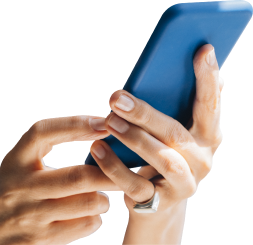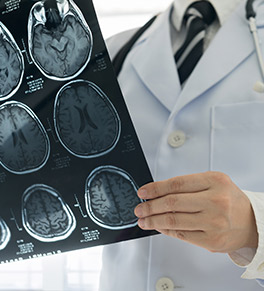
Deep Brain Stimulation
Deep brain stimulation is a safe, painless surgical treatment that eases the symptoms of various movement disorders.
Deep brain stimulation (DBS) reduces these symptoms, powerfully transforming your daily quality of life.
Our approach to deep brain stimulation
At UCI Health, we treat a large variety of movement disorders in our Parkinson's Disease and Movement Disorders Program. The five movement disorders that respond best to DBS are:
- Dystonia
- Epilepsy
- Essential tremor
- Parkinson’s disease
- Tourette’s disorder
Neurology is a complex, ever-evolving field, so it’s not possible to use a cookie-cutter approach to either diagnosis or treatment. Our approach to care is exceptionally patient-centered, compassionate and completely personalized.
We hold a monthly movement disorders conference where we present the specifics of your case to all our colleagues. We decide collaboratively on what treatment is best for you so that your care plan is cohesive.
How to work with us
Most of our deep brain stimulation patients come from either community physician referrals or from referrals within UCI Health.
It’s important that you first meet with a movement disorder neurologist who can assess whether you’re a good DBS candidate. You can find a movement disorder neurologist at our Parkinson's Disease and Movement Disorders Program.
If you are a good candidate, your next step is to work with our neuropsychology experts to undergo neurocognitive testing.
Benefits of DBS
Living with a movement disorder can feel disempowering. It limits your mobility, daily functioning and social life. If you qualify for DBS surgery, the increase in independence and improved motor function is potentially life-changing.
Many of our patients have told our neurosurgeons they wish they’d done the DBS procedure earlier. Although any surgery causes some stress, your brain has no pain receptors, making this procedure virtually painless. Compared to other neurosurgical procedures, it’s also relatively low risk.
What does deep brain stimulation do?
DBS helps you experience improvements in quality of life, tremor, rigidity and bradykinesia (slowness of movement). The DBS device sends an electrical impulse to the areas of your brain that control movement. You never feel or perceive the electrical current.
How does DBS work?
A DBS device has three components:
- We insert a lead, a thin insulated wire, into a very small opening in the skull. It passes through the brain to the targeted area
- We pass an extension, another insulated wire, under the skin of your head and neck to your shoulders
- We implant the battery-operated impulse generator (IPG) beneath the skin near your collarbone, then connect it to the extension wire
How long does DBS last?
Deep brain stimulation lasts a long time and doesn’t have an expiration date. Every manufacturer of DBS devices now includes very small rechargeable batteries for the impulse generator. That means you no longer need to have it surgically re-implanted every three to five years or when the battery runs out.
Am I a candidate for DBS?
You may be a good candidate for deep brain stimulation if you:
- Have had Parkinson's disease symptoms for at least five years
- Have symptoms that fluctuate on and off, with or without involuntary movements
- Respond well to medications, although for shorter periods of time
- Have tried varying combinations of medications under the supervision of a neurologist who specializes in movement disorders
- Have symptoms that interfere with daily activities
Who is not a good candidate for deep brain stimulation?
If you have dementia, you’re not a good candidate. If you have late-stage Parkinson’s and are no longer responding well to medication, you won’t respond to DBS.
There are disorders that look like Parkinson's, but are actually more rapidly progressive neurodegenerative disorders called Parkinson’s plus. These disorders don’t improve with deep brain stimulation.
Will I be able to stop at least some or all of my medications after DBS surgery?
You may be able to reduce some of your medications after DBS surgery.
When we scan your brain to determine where to place the device, we call that brain location the target. Depending on which target we decide to use, you may be able to come off a portion of your medications. Most patients usually do need some medication.

Recapture a better quality of life
Coping with a movement disorder can be confusing and overwhelming. You don’t need to do it alone—partner with us to work with a compassionate team of DBS specialists.
Call 714-456-3656 to make an appointment.
Need to see a neurologist quickly?
Benefits of deep brain stimulation
- Greatly reduces tremors, ticks, shaking, and jerky or stiff movements
- Improves your fine motor skills (writing, grasping, buttoning, etc.)
- Enhances your independence and quality of life
- Decreases medication needs
- Minimally invasive procedure, usually with local anesthesia
- Surgery creates sensation of pressure, but is painless
- Fast recovery—go home the next day
- Safe procedure with extremely low infection rates
- All the experts you need work together in the same institution which reduces stressful and disjointed care
What to expect
After your neurosurgeon conducts an examination, gets a medical history and understands your goals, they’ll send you for neurocognitive testing. Your neurosurgeon will discuss your case with your neurologist. Then they’ll put you on the schedule for discussion at our monthly interdisciplinary movement disorder conference.
Once we’ve decided on treatment, we’ll explain surgical details and schedule the procedure. We perform surgery in two sessions, first to insert the wires, then after a week or so, we insert the generator.
In the operating room
We put a head frame on you to keep your head still during the surgery.
You’ll have a CT scan in the operating room and then we position you for the surgery. We merge the CT with your MRI to determine the coordinates to place the electrodes.
To insert each wire, we make two small incisions in the frontal area while you’re under light sedation. We use micro electrode recording to record your neurons. Then we wake you up and have you move your hands to see how the neurons respond to your movements.
We insert the wires and take another CT scan to make sure they’re placed properly. We close up and then you go home the next day.
The second surgery is an outpatient procedure
The second procedure is about a week later. We connect the leads to a generator that we place underneath your right clavicle. The procedure is about an hour, then you rest for a while before going home.
What happens after my deep brain stimulation treatment?
After your deep brain stimulation surgeries, you’ll meet with your neurosurgeon to make sure you’re healing well. Then, the next step is to meet with your neurologist who will program the device for you.About three months later, your neurosurgeon will have you come in again to see how you’re progressing. For Parkinson's disease, it usually takes about six months to optimize your medications and balance them with the stimulation.
Why choose UCI Health for deep brain stimulation?
There are three manufacturers who make DBS devices – we carry all three
Each device has slightly different features and advantages. Between your needs and your surgeon’s preferences, we’ll find the best device for you. Having all three available gives you and your doctor the most options.
Our multidisciplinary care means you have access to a concentration of experts in one place
If you partner with us for deep brain stimulation treatment, your team might consist of:
-
Neurologists
-
Neuropsychologists
-
Neurosurgeons
-
Neuroradiologists
-
Physical therapists
-
Nurse navigators
Your neurologist and neurosurgeon work together to be able to choose the best target and the best device. Our team approach ensures they can communicate quickly in case anything happens, the lead fractures or just to answer questions.
We prevent suboptimal outcomes by discussing your case and then making decisions as a group.
You don’t need to be scared of deep brain stimulation surgery
DBS is a very safe procedure with a low risk of infection, quick recovery time and beneficial results. This surgical treatment is minimally invasive, an approach that’s gentler overall. This alleviates some of the stress of dealing with a challenging illness.
We’re always available for a second opinion
A patient came to us because another hospital said she wasn’t a good DBS candidate. They said her brain had too much cerebral atrophy, but one of our neurologists took another look with a new brain MRI.
Our doctors let her know that cerebral atrophy is not usually contraindicated for movement disorder surgical treatments.
You can always reach out to us directly for a second opinion.
Featured Blog Posts

Parkinson’s disease: Knowledge is power

UCI Health epilepsy program delivers what others can't

Patient proves it’s never too late for epilepsy surgery
Upcoming Events
Parkinson's Disease Support Group
The UCI Health Parkinson's Disease Support group provides a place where patients can discuss their diagnosis, treatments, etc.




